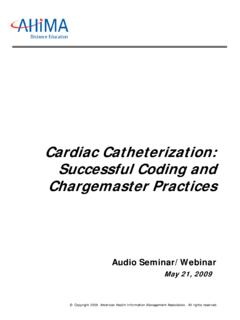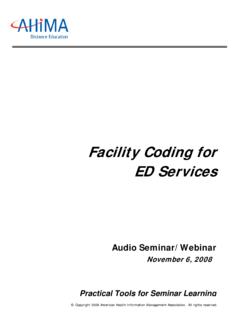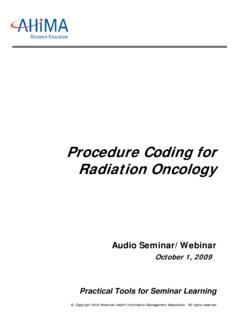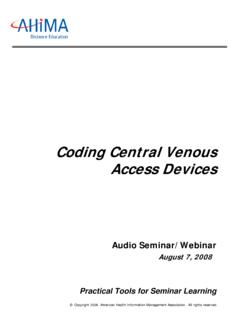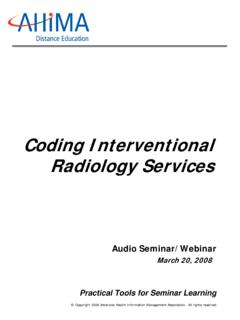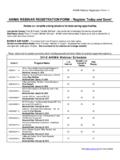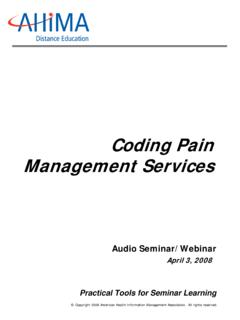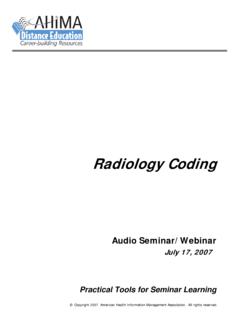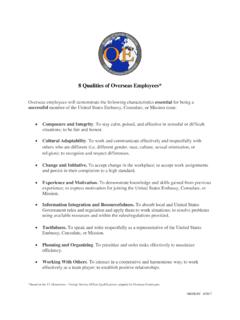Transcription of Chapter 3 Content and Structure of the Health Record
1 Learning Objectives To understand the Content of Health records in various healthcare settings To recognize the documentation requirements of accreditation organizations and state and federal government agencies To describe the different formats used for Health records in healthcare organizations To understand the advantages of electronic Health records over paper-based and hybrid Health recordsKey TermsAccreditationAccreditation Association for Ambulatory Health Care (AAAHC)Advance directiveAmerican Osteopathic Association (AOA)Anesthesia reportAuthorization to disclose informationAutopsy reportCare planCertificationCommission on Accreditation of Rehabilitation Facilities (CARF)Computer-based patient Record (CPR)Conditions for CoverageConditions of ParticipationConsent to treatmentConsultation reportChapter 3 Content and Structure of the Health RecordBonnie J. Petterson, PhD, RHIA47 Copyright 2007 by the American Health Information Management Association.
2 All rights reserved. 48 Chapter 3 Deemed statusDischarge summaryElectronic Health Record (EHR)Electronic medical Record (EMR)Expressed consentHybrid Health recordImaging technologyImplied consentIntegrated Health recordsJoint Commission on Accreditation of Healthcare Organizations (JCAHO)LicensureMedical historyMedical staff privilegesMedicare Conditions of Participation or Conditions for CoverageMinimum Data Set (MDS) for Long-Term CareNational Committee for Quality Assurance (NCQA)Operative reportOutcomes and Assessment Information Set (OASIS)Palliative carePathology reportPatient assessment instrument (PAI)Patient history questionnairePatient Self-Determination Act (PSDA)Patient s bill of rightsPersonal Health Record (PHR)Physical examination reportPhysician s ordersProblem listProblem-oriented Health recordsProgress notesRecovery room reportResident assessment instrument (RAI)
3 Resident assessment protocol (RAP)Source-oriented Health recordsTransfer Record Copyright 2007 by the American Health Information Management Association. All rights reserved. Content and Structure of the Health Record 49 IntroductionAs explained in Chapter 2, the Health Record has multiple purposes. One of its primary purposes is the documentation of patient care. It represents the main communication mechanism used by healthcare providers in the delivery of patient treatment. Without it, providers would be unable to provide safe and effective more than a century, Health records were created and maintained in paper-based formats. In recent years, however, many healthcare providers have implemented computer-based Health records. As the demand for Health information increases and as healthcare facilities adopt advanced information technology, computer-based records will eventually replace most paper-based Health records.
4 A number of different terms have been used to describe computer-based records. Today, electronic Health Record (EHR) is the term used most widely by the federal government and other entities. It refers to a Health Record available electronically allowing communication across providers and permitting real-time decision making. It also allows for efficient reporting mechanisms. Other terms used more commonly in the past include electronic medical Record (EMR) and computer-based patient Record (CPR) (Mon 2004a). When a facility is transitioning from paper to elec-tronic systems and uses components of both, the Record is referred to as a hybrid Health Record . Chapter 4 discusses the EHR in more Chapter describes the basic Content of acute care Health records and then provides specialized information requirements of other healthcare settings. It also introduces the documentation methods required by government and accreditation organizations.
5 Finally, the Chapter discusses the formats of paper-based, hybrid, and electronic Health records and compares their strengths and into PracticeMajor shifts in the way physicians, organizations, hospitals, and other Health settings man-age Health records are beginning to appear throughout the United States. The following real-life case is an example of the steps an organization takes in the transition from paper-based Health Record formats to computer-based Clinic Hospital, a 205-bed acute care hospital located in Phoenix, Arizona, has close to 350 physicians from more than 65 medical and surgical specialties on its medical Phoenix hospital opened in the fall of 1998 with a hybrid Health Record . Much of the care Record is entered and accessed via vendor-purchased, site-edited software. The conditions of admission, consents and authorizations, physician progress notes, physician orders, anesthesia and sedation reports, interoperative records, emergency and ambulatory surgery records, and patient discharge instructions and referrals are paper documents.
6 Emergency visit documents are gathered six hours after patient release and are scanned into the electronic system. All dictated physician reports (history and physicals, opera-tive reports, consultations, and discharge summaries) are immediately available in the electronic Record after transcription. Paper versions of the reports are scanned into the imaging system upon patient discharge for purposes of obtaining physicians electronic signatures. All other documentation, including that done by nursing, therapists, and other Health professionals, and diagnostic or therapeutic testing, including imaging, are recorded and reported electronically. The facility is currently investigating a computerized physician order-entry (CPOE) component and anticipates that it, along with an automated prescrip-tion pad, will be its next electronic 2007 by the American Health Information Management Association.
7 All rights reserved. 50 Chapter 3 discharge Record analysis (reviewing the Record upon patient discharge for missing elements) is done by Health information personnel using a computer. The system filters documents so that only those needing review are accessed. Electronic signatures are used and physicians can enter the system at any of the Arizona Mayo sites. E-mail notices to physicians on Record deficiencies are generated automatically upon completion of analy-sis. Although the parts of the Record generated on paper are stored for a very short period of time after scanning, all release of information and other processes, including coding, use the computer-based fourteen miles away, Mayo Clinic s outpatient clinic practice uses the same electronic Record . Computers are located in each examination room and in stations outside the rooms. Information such as current medications and allergies can be entered directly.
8 Progress notes from all patient visits at the clinic and from the three primary care practice sites located elsewhere in the metropolitan area are dictated immediately after each visit. Similar to hospital-dictated reports, they are transcribed and made immediately available as part of the electronic Record . Paper documents in the outpatient setting include consents, insurance cards, and miscellaneous specialty-specific documentation. All paper documents are picked up hourly by Health information personnel, scanned and indexed into the imag-ing system, and reviewed for quality. The scanned material is available in the electronic Record within two to four hours of the pickup Falk, supervisor of medical records at Mayo Clinic Hospital, and Yolanda Nichols, her counterpart at the clinic, note, however, that the Mayo facilities in Rochester, Minnesota, and Jacksonville, Florida, currently have site-specific electronic records.
9 There is some shar-ing of information (for example, Minnesota and Arizona have the same registration/billing systems, utilize the same transcription database, and all three sites use the same radiology system). Improving interoperability across the country is a Mayo of the Health RecordFirst and foremost, the Health Record is a tool for documenting patient care. The informa-tion in the Health Record is provided directly by the healthcare professionals who partici-pate in the patient s care. This information is used for: Planning and managing diagnostic, therapeutic, and nursing services Evaluating the adequacy and appropriateness of care Substantiating reimbursement claims Protecting the legal interests of the patient, the healthcare provider, and the healthcare organizationIn addition, the Health Record is a tool used by the patient s caregivers to communicate with each other.
10 Finally, information collected from Health records is used for research, public Health , and educational and organizational activities such as medical research, pro-fessional training, performance improvement, risk management, and strategic Health Record generally contains two types of data: clinical and administrative. Clinical data document the patient s medical condition, diagnosis, and treatment as well as the healthcare services provided. Administrative data include demographic and financial information as well as various consents and authorizations related to the provision of care and the handling of confidential patient 2007 by the American Health Information Management Association. All rights reserved. Content and Structure of the Health Record 51 The Content of the Health Record varies, depending on the healthcare setting and the provider s medical specialty. Record Content is determined primarily by practice needs and pertinent standards.
